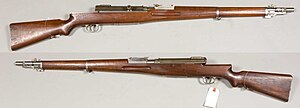General Liu rifle
| General Liu Rifle | |
|---|---|
 A sample from the Swedish Army Museum, manufactured in 1915 | |
| Type | Semi-automatic / Straight-pull bolt action rifle |
| Place of origin | Republic of China (1912–49) |
| Production history | |
| Designer | General Liu Qing En[1][2] |
| Designed | ca. 1914 |
| Manufacturer | Hanyang Arsenal,[1][2] Pratt & Whitney Machine Tool |
| Produced | 1914–1918 |
| No. built | approx. 10 |
| Specifications | |
| Mass | 4.7 kg (10 lb 6 oz) empty |
| Length | 122.5 cm (48.2 in) |
| Barrel length | 64.7 cm (25.5 in) |
| Cartridge | 7.9x57mm S-Patrone[1] |
| Caliber | 7.92 mm |
| Action | Gas operated, rotating bolt[3] |
| Muzzle velocity | 780 m/s (2,600 ft/s)[1] |
| Feed system | Integral magazine, 6 round capacity[1] |
| Sights | Rear: Ladder graduated 400–2000 m[1] Front: Blade |
The General Liu rifle is a semi-automatic rifle named after its inventor and the first Superintendent of Hanyang Arsenal, General Liu Qing En (1869–1929),[1] as the rifle never received any other designation. It was one of the first Chinese semi-automatic rifles. The rifle used a muzzle "gas-trap" system similar to the Bang rifle[3][4] (other rifles including this system were the Gewehr 41 and early production models of M1 Garand). The rifle's method of operation could be switched from gas to straight-pull bolt action by rotating counterclockwise the cylinder located on the muzzle, to revert to gas-operated reloading the cylinder had to be rotated back (clockwise). The stock had a compartment for cleaning tools.[1]
History
At the beginning of 1914 General Liu contacted Pratt & Whitney Tool Company, Hartford in order to purchase machinery for Hanyang Arsenal. A contract for US$1,082,500 was signed with the company on April 11, with an expected delivery in 24 months. Later that year, on September, Liu along with his family and seven subordinates arrived at Hartford, the purpose of the visit was to familiarize with the machinery. Liu stayed at Hartford at least until June 1915.[5] On September 8, 1916, two versions of the rifle were tested at Nan Yuan Proving Ground in Beijing. The first version was made at Hanyang with a hand-made driving spring, the second was manufactured at Pratt & Whitney and had a machined spring. The test revealed that the hand-made springs proved to be too weak to properly cycle the rounds, as opposed to the ones produced in USA.[6] In 1918 two rifles were tested at Springfield Armory by Julian Hatcher.[7] In the summer of 1919 during an Army Department meeting Liu suffered a stroke which caused paralysis of one side of his body, supposedly due to the fact that the vessel with the machinery onboard sank on its way to China.[8] Later that year the machinery was recovered and arrived at Shanghai. It was kept in a warehouse until 1921, when it was diverted to Gongxian Arsenal.[1] After being sent to Gongxian, in an ironic twist, the machinery and tooling equipment was later redirected back to Hanyang but this did not happen until 1935. When the machinery arrived at Hanyang, it was set up and initially used to manufacture Hanyang 88 rifles but was later changed to produce Type 24 Chiang Kai-shek rifles.
References
- ^ a b c d e f g h i Shih, Bin; Stan Zielinski (2004). "The First Chinese Semi-Automatic Rifle by General Liu Qing En". Military Rifle Journal. Retrieved 27 January 2014.
- ^ a b Josh. "Hanyang Arsenal and Its Place in Chinese History". Archived from the original on 2 February 2014. Retrieved 28 January 2014.
- ^ a b Hatcher, Julian S. (1948). The Book of the Garand. Washington: Infantry Journal Press. pp. 21–22.
- ^ Hatcher 1966, p. 147.
- ^ Shih, Bin. "e-mail from Bin Shih". Archived from the original on 4 March 2016. Retrieved 23 May 2014.
{{cite web}}: CS1 maint: bot: original URL status unknown (link) - ^ "Army Materiel Command's test in Nan-Yuan Proving Grounds on the new rifle by General Liu Qing-En, referred to as the self-loading rifle ('SLR')" (PDF). Archived from the original on 2022-11-27. Retrieved 2023-03-03.
{{cite web}}: CS1 maint: bot: original URL status unknown (link) - ^ Hatcher, Julian S. (1947). Hatcher's Notebook. Harrisburg: Military Service Publishing Company. p. 383.
- ^ "American Rifleman - Chinese Liu Rifle". www.americanrifleman.org. Archived from the original on 2013-12-05.
External links
- Springfield Armory Museum Record
- General Liu rifle
- Rare Chinese Liu semi-auto military rifle. A National Firearms Museum Treasure Gun. [1]
- Bin Shih and the General Liu Rifle
- photograph of General Liu
- Hanyang report on the General Liu Rifle
- Hanyang report on the General Liu Rifle (in Chinese)
- The first Chinese semi-automatic rifle by General Liu Qing En 國造半自動步槍第一人- 劉慶恩將軍
- From the October 2003 issue, pages 261 - 264
- Semiauto Rifles of WWI and Before
- Rare Chinese Liu Semi-Automatic Military Rifle
